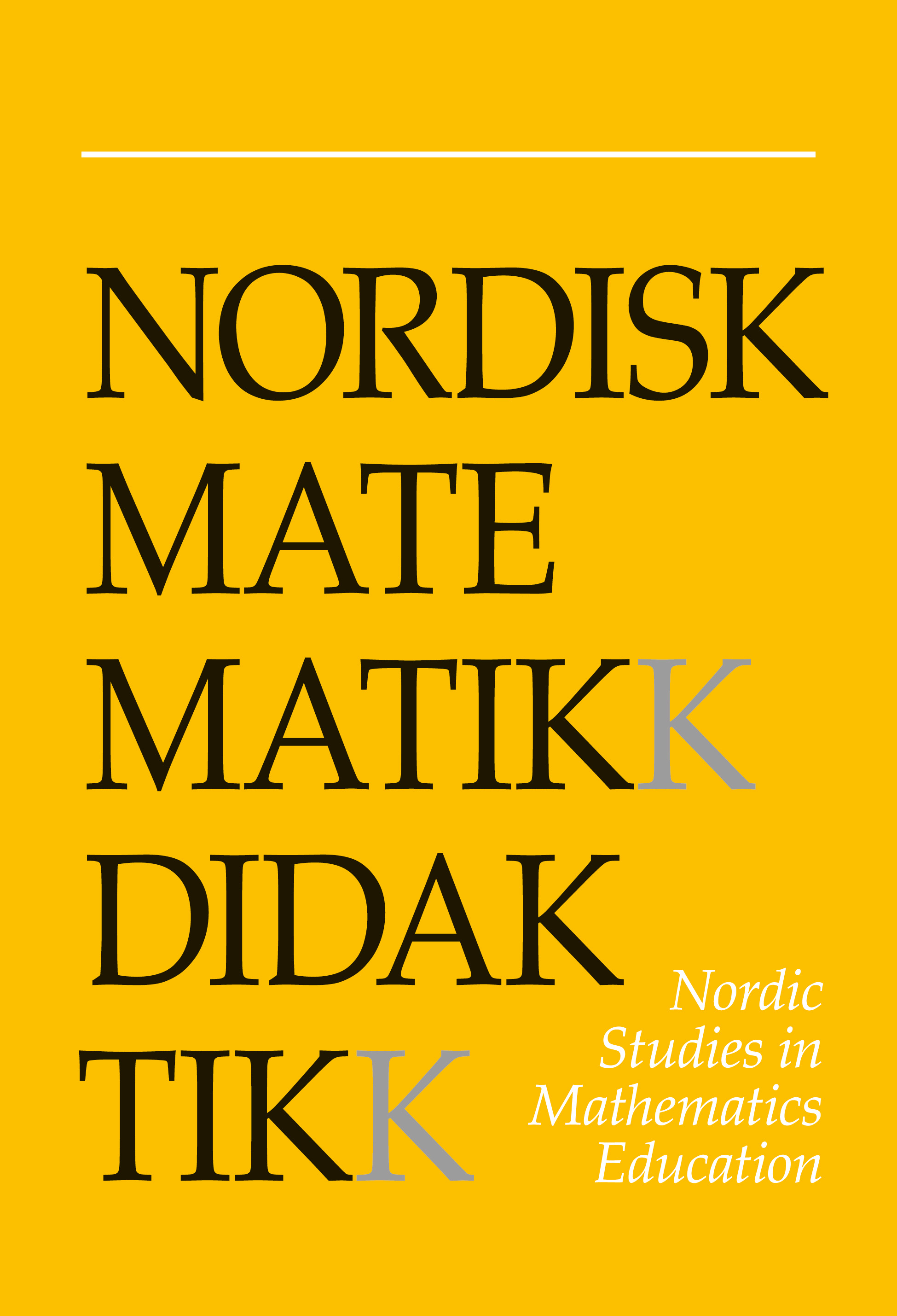Scrutinizing Norwegian kindergarten teachers’ considerations about talk moves
DOI:
https://doi.org/10.7146/nomad.v27i2.149187Abstract
Talk moves have been used as a communication tool for developing more productive mathematical discussions in school. To avoid uncritical adoption of a tool that was developed in a different context, it is important to consider cultural differences and concerns from the practice field. This study investigates group discussions among 15 Norwegian kindergarten teachers from seven kindergartens to explore how they understand talk moves, and what they consider to be possibilities and limitations of using talk moves in the Norwegian kindergarten context. We argue that kindergarten teachers’ concerns about talk moves do not seem to warrant rejection, but that professional efforts are required for meaningful enactment.
References
Barnes, D. (1976). From communication to curriculum. Penguin Books.
Breive, S. (2020). The materialisation of children's mathematical thinking through organisation of turn-taking in small group interactions in kindergarten. In M. Carlsen, I. Erfjord & P. S. Hundeland (Eds.), Mathematics education in the early years: results from the POEM4 conference, 2018 (pp. 281-299). Springer Nature. https://doi.org/10.1007/978-3-030-34776-5_17
Carlsen, M. (2013). Engaging with mathematics in the kindergarten. Orchestrating a fairy tale through questioning and use of tools. European Early Childhood Education Research Journal, 21 (4), 502-513. https://doi.org/10.1080/1350293X.2013.845439
Cazden, C. B. (2001). Classroom discourse: the language of teaching and learning. Heinemann.
Chapin, S. H., O'Connor, C. & Anderson, N. C. (2009). Classroom discussions. Using math talk to help students learn. Math Solutions.
Cohen, D. K. (2011). Teaching and its predicaments. Harvard University Press. Dillon, J. T. (1994). Using discussion in classrooms. Open University Press. https://doi.org/10.4159/9780674262720
Dovigo, F. (2016). Argumentation in preschool: a common ground for collaborative learning in early childhood. European Early Childhood Education Research Journal, 24 (6), 818-840. https://doi.org/10.1080/1350293X.2016.1239327
Fosse, T. (2016). What characterises mathematical conversations in a Norwegian kindergarten? Nordic Studies in Mathematics Education, 21 (4), 135-153.
Gjems, L. & Løkken, G. (2011). Barns læring om språk og gjennom språk: samtaler i barnehagen. Cappelen Damm.
Herbel-Eisenmann, B. A., Steele, M. D. & Cirillo, M. (2013). (Developing) Teacher discourse moves: a framework for professional development. Mathematics Teacher Educator, 1 (2), 181-196. https://doi.org/10.5951/mathteaceduc.1.2.0181
Jacobs, V. R. & Spangler, D. A. (2017). Research on core practices in K-12 mathematics teaching. In J. Cai (Ed.), Compendium for research in mathematics education (pp. 766-792). NCTM.
Kazemi, E. & Hintz, A. (2014). Intentional talk. How to structure and lead productive mathematical discussions. Stenhouse.
Mehan, H. (1979). Learning lessons: social organization in the classroom. Harvard University Press. https://doi.org/10.4159/harvard.9780674420106
Mercer, N. & Hodkinson, S. (2008). Exploring talk in school. Sage.
Michaels, S. & O'Connor, C. (2015). Conceptualizing talk moves as tools: professional development approaches for academically productive discussions. In L. Resnick, C. Asterhan & S. Clarke (Eds.), Socializing intelligence through academic talk and dialogue (pp. 333-347). AERA. https://doi.org/10.3102/978-0-935302-43-1_27
Norwegian Directorate for Education and Training (2017). Framework plan for kindergartens - content and tasks. Ministry of Education and Research. https://www.udir.no/globalassets/filer/barnehage/rammeplan/framework-plan-for-kindergartens2-2017.pdf
OECD (2017). Starting strong V: transitions from early childhood education and care to primary education. OECD. https://doi.org/10.1787/9789264276253-en
O'Connor, C. & Michaels S. (2017). Supporting teachers in taking up productive talk moves: the long road to professional learning at scale. International Journal of Education Research, 97, 166-175. https://doi.org/10.1016/j.ijer.2017.11.003
Ryve, A. (2011). Discourse research in mathematics education: a critical evaluation of 108 journal articles. Journal for Research in Mathematics Education, 42 (2), 167-199. https://doi.org/10.5951/jresematheduc.42.2.0167
Schwab, J. J. (1954). Eros and education: a discussion of one aspect of discussion. The Journal of General Education, 8 (1), 51-71.
Stein, M. K., Engle, R. A., Smith, M. S. & Hughes, E. K. (2008). Orchestrating productive mathematical discussions: five practices for helping teachers move beyond show and tell. Mathematical Thinking and Learning, 10 (4), 313-340. https://doi.org/10.1080/10986060802229675
Sæbbe, P. E. (2019). Barnehagelæreres "matematikkundervisning" i barnehagen [Kindergarten teachers' "mathematics teaching" in kindergarten] (Ph. d. thesis). University of Stavanger. https://hdl.handle.net/11250/2690289
Sæbbe, P. E. & Pramling Samuelson, I. (2017). Hvordan underviser barnehagelærere? Eller gjør de ikke det i barnehagen? [How do kindergarten teachers teach? Or don't they do that in kindergarten?]. Nordic Early Childhood Education Research Journal, 14 (7), 1-15. https://doi.org/10.7577/nbf.1731
Wæge, K. (2015). Samtaletrekk - redskap i matematiske diskusjoner [Talk moves - tools in mathematical discussions]. Tangenten, 2, 22-27.
Downloads
Published
How to Cite
Issue
Section
License

This work is licensed under a Creative Commons Attribution-NonCommercial-ShareAlike 4.0 International License.



